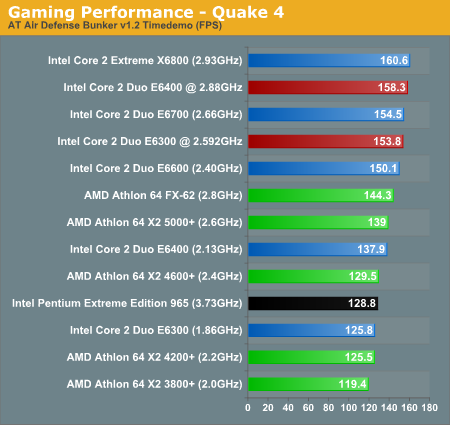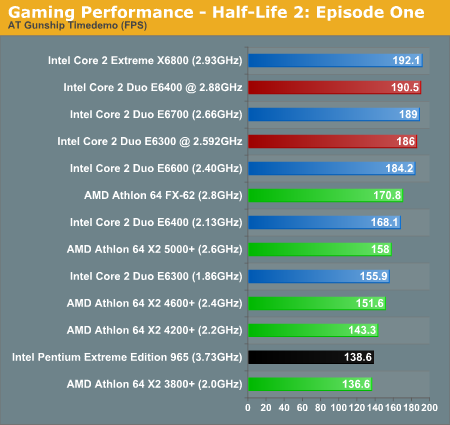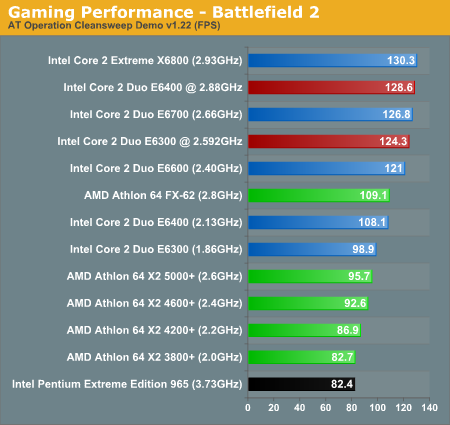Intel Core 2 Duo E6300 & E6400: Tremendous Value Through Overclocking
by Anand Lal Shimpi on July 26, 2006 8:17 AM EST- Posted in
- CPUs
Gaming Performance using Quake 4, Battlefield 2 & Half-Life 2 Episode 1
Our gaming performance analysis starts out with Quake 4 running at 1600 x 1200 with High Quality visual settings. We used version 1.2 of Quake 4 and SMP was enabled:

Once we shift over to gaming performance, the differences between all of the tested systems are greatly diminished. Enabling 4xAA would further reduce the difference, to the point where most of the systems would be about equal. This does not change the fact that the Core 2 Duo chips are able to outperform their AMD counterparts in terms of raw performance, so once faster graphics cards become available we should see the processors begin to differentiate themselves more. Of course, by then we might also have games that are more demanding of the GPU.
Looking specifically at Quake 4 performance -- and remember that this is one of the few games that can truly take advantage of multiple processor cores -- the Core 2 processors continue to outperform their AMD counterparts, but only by a small margin. The overall spread between the X6800 and the X2 3800+ is 35%, which is certainly noticeable, but with frame rates that are all averaging over ~120 FPS Quake 4 is clearly going to run well on all of the tested systems. We had hoped to include Prey performance as well, so that we could see how an updated Quake 4/Doom 3 engine game performs, but we ran into benchmarking issues that we are currently investigating.
Next up we've got the recently released Half Life 2: Episode 1, running at default quality settings (auto detected with a pair of X1900 XTs installed) with the exception of AA and aniso being disabled. As with all of our gaming tests in this article we tested at 1600 x 1200:

In Half-Life 2: Episode One, the Performance spread is 41%. At the top end of the spectrum, we're beginning to become GPU limited even without antialiasing enabled. Valve's Source engine clearly likes the Core 2 architecture, as even without overclocking the E6300 and E6400 clearly perform better than their similarly priced AMD counterparts.

Battlefield 2 is a game that has consistently demonstrated it is more CPU limited than GPU limited, especially with high-end graphics solutions. Here the spread between the processors is 58%, and the E6300/E6400 without overclocking are faster than everything from AMD except for the FX-62. At the top end of the spectrum, we finally begin to reach the limitations of our GPUs, with the top four systems all performing within 3% of each other.










137 Comments
View All Comments
getbush - Wednesday, July 26, 2006 - link
There is a for that should be four and you start the oblivion page with will instead of we'll.JarredWalton - Wednesday, July 26, 2006 - link
Thanks - I gave the document a final proofing now that I'm a bit more coherent and squashed several more "typos" (speech-recognition-os?) I helped Anand fill in a bunch of the text, but it was late and my eyes weren't cooperating. LOLyacoub - Wednesday, July 26, 2006 - link
What I see here is that the E6400 is easily the way to go for folks who aren't interested in overclocking but want the best bang-for-the-buck.For very little more $$ than the E6300, you get a chip that rides quite a bit higher up on the charts in many tests.
Now the question: What affordable motherboard is recommended for stable, reliable non-overclocked C2D Conroe performance? Perhaps the Intel P965 board?
There's no reason to drop $200-250 for a motherboard when you aren't going to utilize its overclocking functionality. I believe that opens up the user to the more affordable P965 boards, right? They tend to be more around $150 and if it's made by Intel it should be plenty stable, right?
Also most boards now are passively-cooled which is excellent since the dinky fans on older motherboards were always noisy and died quickly. Avoiding those is another benefit as I believe the Intel P965 board is passively cooled as well.
Thoughts?
anandtechrocks - Wednesday, July 26, 2006 - link
Check out the Gigabyte DS3. It uses the P965 chipset and costs ~$144. It overclocks just as well as the $250 Asus motherboard in this article and it uses very high quality solid capacitors. Only drawback is that no SLI or Crossfire.yacoub - Wednesday, July 26, 2006 - link
I don't know, looks like there's some cause for concern about currently available 965 boards now...http://forums.anandtech.com/messageview.aspx?catid...">http://forums.anandtech.com/messageview...amp;thre...
anandtechrocks - Wednesday, July 26, 2006 - link
Very good article, I really enjoyed it. I think there is an error on page 4, on the 3rd graph from the bottom. The E6300 and E6400 bars are miss-labled.JarredWalton - Wednesday, July 26, 2006 - link
Fixed - thanks.code65536 - Wednesday, July 26, 2006 - link
How do the OC'ed chips do with power consumption. Does a 6400 @ 2.88 use more or less power than a 6800, for example?supremelaw - Wednesday, July 26, 2006 - link
... and heat.I assume that the stock Intel HSF hasn't changed:
http://www.supremelaw.org/systems/heatsinks/warnin...">http://www.supremelaw.org/systems/heatsinks/warnin...
and that a superior HSF with proper backing plate
is still recommended for Conroe CPUs, even though
they run cooler in general.
Sincerely yours,
/s/ Paul Andrew Mitchell
Webmaster, Supreme Law Library
http://www.supremelaw.org/">http://www.supremelaw.org/
houe - Wednesday, July 26, 2006 - link
fp